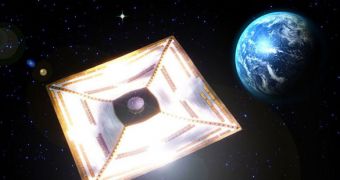Officials at the Japanese Aerospace Exploration Agency (JAXA) announced that engineers were able to deliver a new satellite, and a prototype propulsion system, to their delivery system this weekend. The maneuvers say a Venus-bound weather satellite and a solar sail demonstrator are being delivered to the Tanegashima Space Center. The facility, which is located on a narrow strip of land off the coast of the larger Kyushu Island, will host the H-2A rocket launch. This delivery system will carry the Akatsuki interplanetary spacecraft and the Ikaros demonstrator to orbit on Monday, May 17. Lift-off is scheduled to take place at precisely 2144:14 GMT, Space reports.
The payload components were moved Sunday to the Vehicle Assembly Building, located near the Yoshinobu launch complex at the Tanegashima Space Center. The components were nested inside the delivery system's nose cone, which is about 40 feet tall. Once engineers received the payload, they immediately proceeded to hoisting it up, and then lower it to the other stages of the rocket. Propulsion for the H-2A will be provided by two powerful solid rocket boosters. For this flight, JAXA experts did not see it necessary to add smaller strap-on motors. This will be the 17th launch for this particular rocket, which is the workhorse of the Japanese agency.
Once the integration phase and other preparations for launch are completed, the 17-story-tall rocket will be rolled out to the Launch Pad No. 1 facility. The roll-out and launch will take place the same day. Shortly after the rocket arrives, pad engineers will fuel the first and second stages with their liquid oxygen/liquid hydrogen mix. JAXA officials underline the importance of having the rocket launched at a very precise instant during every window. They explain that this is absolutely necessary in order to ensure a correct insertion into a Venus-bound flightpath.
Akatsuki, which arrived at the space center on March 19, represents the first weather satellite to be sent to another planet. It has a weight of about 1,100 pounds, and the size of a small car, experts say. It is attached to a secondary payload, the Ikaros solar sail, which is meant to be a prototype demonstrator. The sail arrived at Tanegashima in early April. The two spacecrafts, and a host of other, smaller satellites, were all placed inside the nose fairing and encapsulated there on May 4. If the launch is successful on Monday, then Akatsuki will reach Venus by this December. A tight planetary alignment window is opened between May and June, and JAXA needs to launch its Venusian mission until it expires.

 14 DAY TRIAL //
14 DAY TRIAL //